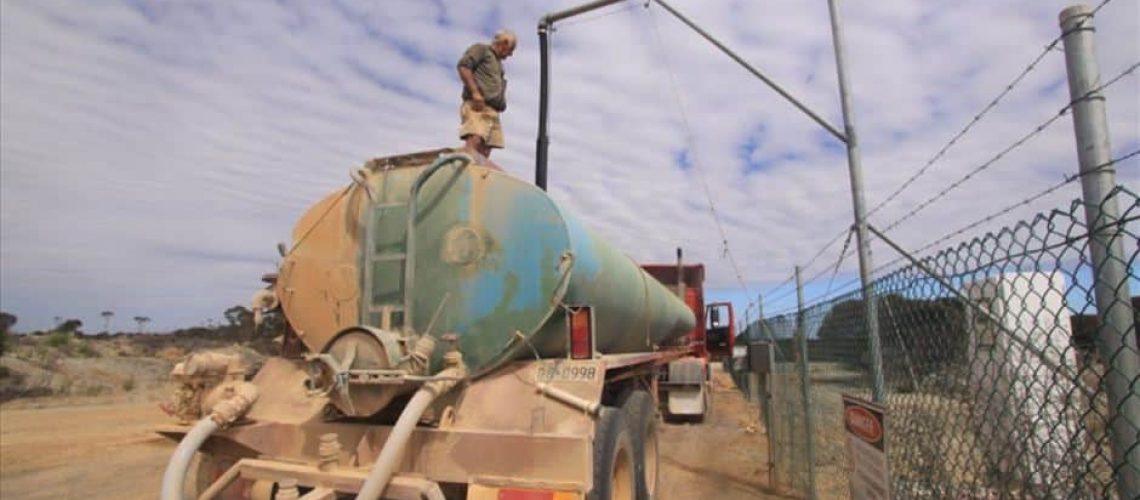Countryman 31 Oct 2019
In their infinite wisdom, the State and Commonwealth governments are marching to the beats of different drums when it comes to subsidising farm water supplies. The state government moved to end their own Farm Water Rebate Scheme 12 months ago. The scheme offered up to $15,000 every ten years to help cover the costs of dams, road catchments and tanks for farmers in districts receiving less than 600mm average annual rainfall.
At the same time that the state government was turning off that tap, the commonwealth government was turning on their new On-Farm Emergency Water Infrastructure Rebate Scheme (EWIRS), which offers a 25% rebate up to a maximum of $25,000 for undertaking similar sorts of farm water investment.
What was the trigger for two different responses to the same issue? In Western Australia it was the first year in office of a state ALP government that held zero seats in the bush and a large budget deficit to reign in, so they took the opportunity to wind up the last of a long list of farm development schemes that stretched back to the 1893 Homesteads Act.
These farm development subsidies had been in the firing line for the past quarter of a century, with a key turning point coming with the Court governments decision of 1993 directing the Department of Agriculture to end the Rural Adjustment and Financial Corporation RAFCOR loan scheme. This program help refinance farms in financial distress along with the construction of farm infrastructure.
It was clear back then that both sides of politics had come to the conclusion that the state government had done its bit, and after 100 years of development support since kickstarting the expansion of the Wheatbelt, it was handing over the responsibility to farmers to fully fund their own infrastructure and business survival.
Federally, the trigger point to go the other way and offer new subsidies was a federal coalition government struggling in its fifth year of office, facing what was turning out to be one of Australia’s worst ever droughts. Water had to be thrown on the political firestorm started by the drought and it came in the form of a raft of new loans and subsidies.
This was despite the various papers and forums put forward from both sides of government during the wet years, which advocated that the time had come for farmers to be more resilient and manage drought themselves.
However when the rain stopped falling, the government rushed to dip into its bucket of funds and splash around drought loans and new subsidies in a rain dance to appease the drought rent seekers.
This included Barnaby’s bank, the Regional Investment Corporation, which offers Farm Investment and Drought Loans of up to $2m at 3.11% to manage or prepare for drought. For those who don’t want more debt there is always the $25,000 (EWIRS) for on-farm emergency drought water infrastructure, but that requires farmers to outlay an additional $75,000 to access the subsidy.
On the surface, what could be more simple? Encourage farmers to prepare for drought by offering subsidies to build bigger on-farm water storage. The only problem is it’s too late when the rain has stopped coming.
But there is something about water that is hard for politicians to say ‘no’ to (just look at the mess that the Murray Darling is in), and in part it is complicated by the fact that water is such an essential ingredient of life. No water no life – but whose life is the government responsible for in the bush? Is it the people and the stock, or just the people?
We know that water is part of government’s core responsibilities making up one of the four essential infrastructure services: water, power, roads and telecommunications. All are essential but on farm, we know the provision of these services does not extend to pressurised mains water and three phase power to the house, nor does it include NBN fibre and bitumen to the front gate. The government will provide a basic service but that’s as far as both sides of politics will go, at least at the state level.
Farmers who live on-farm are realistic and don’t expect country town level of these services. They have long since moved past relying on the state government to underwrite their farm businesses. The removal of the last of the state backed farm development loans and subsidies that supported building their homestead, plumbing into a tank and connecting to SEC power signals an end of an era of state support for farmers.
Part of the problem with the discontinued state-based Farm Water Rebate Scheme is that nowadays, although most farms in the state have the homestead water infrastructure to carry themselves through a drought, they do not have enough water to support their stock or spraying program in a dry season.
So who is responsible for providing this water? Under today’s values of business self-reliance, it’s hard to argue that the taxpayer should pick up the cost of a water tank if it’s used for the farm business and a private benefit, when the cost of the drought and the fodder has been long accepted by a majority of WA farmers as being the responsibility of the farm.
The question should not be if the taxpayer should pick up the cost of another tank; rather the question should revolve around what the state and federal governments should be doing to further encourage farm businesses to gear up to carry themselves and their stock and spraying program through multiple low rainfall years.
The new federal EWRIS scheme, as an example of public funding for private benefit, is a drop in the ocean compared to the amount of drought support funding that is currently flowing to eastern states farmers. How long the funding bucket will last before the funding runs out of funds is a question that should be on potential users’ minds. Like the state government, the federal government is increasingly under pressure to stop subsidising farms and it is likely to take one good year or a change in government to see the scheme dry up. So if you are wanting to access one of the last farm subsidies available, contact [email protected], ph. 1800 780 300
There is one other part of this equation that we need to understand. With or without a state or federal subsidy, the state government still has a problem. During droughts, immense pressure is placed onto the community water supply, the town dam or standpipe that provides back up water to the farms and local towns. Under the current formula, if five or more farmers within a 20 kilometre radius have to travel more than 40km to an off-farm source to access suitable water for livestock, then the local government can make a formal Water Deficiency Declaration request to the Department of Water. This triggers the state government to truck in water for livestock to a central storage point within a 40km radius of the farms concerned.
This year the state government has spent over a million dollars in the Great Southern transporting water to top up one town’s water supply. While it is highly unlikely that retuning the $15,000 state grant or even adding it to the $25,000 federal grant would have prevented this expenditure, the state government needs to undertake a Strategic Rural Water Supply Review to demonstrate that they have worked through the economic, social, environmental and animal welfare impacts of a drying climate, ageing rural water supply system and changing farm water needs.
As part of this review they should consider four things. Firstly, look at the merits of various government farm water schemes that encourage on-farm capture and storage. Should the state scheme be reintroduced? What impact would it have on reducing the cost to the state having to cart water to thirsty towns during droughts.
Secondly, consider the cost benefit of tripling the size of town tanks, stand pipe pressure, town dams and road catchments to ensure ample long term reserves of emergency water at strategic locations for human, stock, community infrastructure and firefighting.
And thirdly, examine the economic farm business motivations that will trigger farmers to build on-farm mega reserve dams of 10,000m3 plus catchment systems to lock in their own strategic water reserve.
The last thing to review is the federal government farm tax incentive for capital investments. Under the current tax rules, there is a 100% deduction on water related infrastructure on-farm, prior to 2015, improvements could only be deducted over three years. If the government wanted to further stimulate investment on a scale that would help drought-proof Australia, maybe it’s time the federal government looked at increasing the deduction to 150% to encourage a flood of farm water investment. Australian farmers pride themselves on not being on the government drip, hence additional tax incentives, rather than subsidies, will probably the biggest motivator to encourage on-farm investment in water security.











